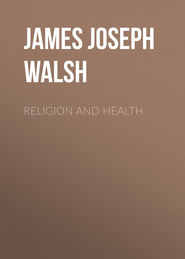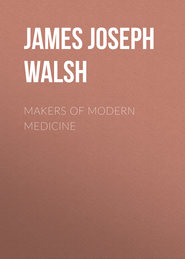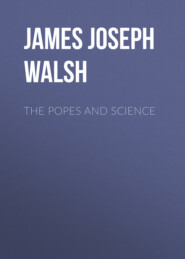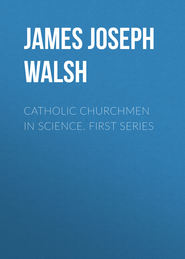По всем вопросам обращайтесь на: info@litportal.ru
(©) 2003-2024.
✖
The Thirteenth, Greatest of Centuries
Настройки чтения
Размер шрифта
Высота строк
Поля
The Thirteenth, Greatest of Centuries
James Walsh
James J. Walsh
The Thirteenth, Greatest of Centuries
PROEM.
(EPIMETHEUS.)
WAKE again, Teutonic Father-ages,
Speak again, beloved primeval creeds;
Flash ancestral spirit from your pages,
Wake the greedy age to noble deeds.
……
Ye who built the churches where we worship,
Ye who framed the laws by which we move,
Fathers, long belied, and long forsaken,
Oh, forgive the children of your love!
(PEOMETHEUS.)
There will we find laws which shall interpret,
Through the simpler past, existing life;
Delving up from mines and fairy caverns
Charmed blades to cut the age's strife.
—Rev. Charles Kingsley.—The Saints' Tragedy.
PREFACE
"Why take the style of these heroic times? For nature brings not back the mastodon—Nor we those times; and why should any man Remodel models?"
What Tennyson thus said of his own first essay in the Idyls of the King, in the introduction to the Morte D'Arthur, occurs as probably the aptest expression of most men's immediate thought with regard to such a subject as The Thirteenth, Greatest of Centuries. Though Tennyson was confessedly only remodeling the thoughts of the Thirteenth Century, we would not be willing to concede—
"That nothing new was said, or else.
Something so said, 'twas nothing,"
for the loss of the Idyls would make a large lacuna in the literature of the Nineteenth Century, "if it is allowed to compare little things with great," a similar intent to that of the Laureate has seemed sufficient justification for the paradox the author has tried to set forth in this volume. It may prove "nothing worth, mere chaff and draff much better burnt," but many friends have insisted they found it interesting. Authors usually blame friends for their inflictions upon the public, and I fear that I can find no better excuse, though the book has been patiently labored at, with the idea that it should represent some of the serious work that is being done by the Catholic Summer School on Lake Champlain, {viii} now completing nearly a decade and a half of its existence. This volume is, it is hoped, but the first of a series that will bring to a wider audience some of the thoughts that have been gathered for Summer School friends by many workers, and will put in more permanent form contributions that made summer leisure respond to the Greek term for school.
The object of the book is to interpret, in terms that will be readily intelligible to this generation, the life and concerns of the people of a century who, to the author's mind, have done more for human progress than those of any like period in human history. There are few whose eyes are now holden as they used to be, as to the surpassing place in the history of culture of the last three centuries of the Middle Ages. Personally the author is convinced, however, that only a beginning of proper appreciation has come as yet, and he feels that the solution of many problems that are vexing the modern world, especially in the social order, are to be found in these much misunderstood ages, and above all in that culmination of medieval progress—the period from 1200 to 1300.
The subject was originally taken up as a series of lectures in the extension course of the Catholic Summer School, as given each year in Lent and Advent at the Catholic Club, New York City. Portions of the material were subsequently used in lectures in many cities in this country from Portland, Me., to Portland, Ore., St. Paul, Minn., to New Orleans, La. The subject was treated in extenso for the Brooklyn Institute of Arts and Sciences in 1906, after which publication was suggested.
The author does not flatter himself that the book adequately represents the great period which it claims to present. The subject has been the central idea of studies in leisure moments for a dozen years, and during many wanderings in Europe but there will doubtless prove to be errors in detail, for which the author would crave the indulgence of more serious students {ix} of history. The original form in which the material was cast has influenced the style to some extent, and has made the book more wordy than it would otherwise have been, and has been the cause of certain repetitions that appear more striking in print than they seemed in manuscript. There were what seemed good reasons for not delaying publication, however, and leisure for further work at it, instead of growing, was becoming more scant. It is intrusted to the tender mercies of critics, then, and the benevolent reader, if he still may be appealed to, for the sake of the ideas it contains, in spite of their inadequate expression.
PREFACE.
(GEORGETOWN UNIVERSITY EDITION)
This third edition is published under the patronage of Georgetown University as a slight token of appreciation for the degree of Doctor of Letters, conferred on the author for this work at the last Commencement. This issue has been enlarged by the addition of many illustrations selected to bring out the fact that all the various parts of Europe shared in the achievements of the time and by an appendix containing in compendium Twenty-Six Chapters that Might Have Been. Each of these brief sketches could easily have been extended to the average length of the original chapters. It was impossible to use all the material that was gathered. These hints of further sources are now appended so as to afford suggestions for study to those who may care to follow up the idea of the Thirteenth as The Greatest of Centuries, that is, of that period in human existence when man's thoughts on all the important human interests were profoundly valuable for future generations and their accomplishments models for all the after time.
PREFACE.
(FOURTH EDITION)
Many of the now rather numerous readers and hearers of this book, for it has been read in the refectories of over 200 religious communities, have said that the title seemed almost deterring at first because of the high claim that is set up for a medieval century. To mitigate the possible initial deterrent effect of the paradox of the Thirteenth as the Greatest of Centuries, it has seemed worth while in this edition then to premise a series of quotations from some of the most distinguished historical writers in English of our own time which amply justify the claim here set up. Frederic Harrison, Macaulay, Freeman, and Fiske are sufficiently different in themselves to make their agreement in supreme admiration for the Thirteenth Century very striking. In spite of their lack of sympathy with many things in the period, all of them emphatically declare that it is the source of most that is great and good since, and that while we have added details, we have failed to surpass its artistic and intellectual achievement in all the 700 years that have elapsed.
August 15, 1912.
PREFACE.
(FIFTH EDITION)
After the success of the Knights of Columbus edition of the Popes and Science of which 40,000 were issued it gives me great pleasure to accede to the request of the Supreme Officers of the Order to permit them to issue a correspondingly large edition of the present volume. The good work which the Knights of Columbus have thus done in diffusing a knowledge of the true relations of the Church to science,—generous patronage and encouragement, instead of supposed opposition,—will, I think, be greatly furthered by the wide distribution of the information contained in this volume with regard to the supremely helpful attitude of the Church towards art and architecture, literature, education and above all the important social problems, which is so well illustrated during the great period of the Thirteenth Century. I sincerely hope that brother Knights of Columbus will find in the book some of that renewal of devotion to Mother Church that came as the result of my own studies of this glorious period of her history, when her action was untrammelled by political considerations and when she was free to express herself in every great movement for the benefit of humanity.
Feast of the Immaculate Conception, 1912.
FREDERIC HARRISON, MACAULAY,
FREEMAN, AND FISKE
ON THE PLACE OF THE THIRTEENTH CENTURY IN HISTORY
Of all the epochs of effort after a new life, that of the age of Aquinas, Roger Bacon, St. Francis, St. Louis, Giotto, and Dante is the most purely spiritual, the most really constructive, and indeed the most truly philosophic. … The whole thirteenth century is crowded with creative forces in philosophy, art, poetry, and statesmanship as rich as those of the humanist Renaissance. And if we are accustomed to look on them as so much more limited and rude it is because we forget how very few and poor were their resources and their instruments. In creative genius Giotto is the peer, if not the superior of Raphael. Dante had all the qualities of his three chief successors and very much more besides. It is a tenable view that in inventive fertility and in imaginative range, those vast composite creations—the Cathedrals of the Thirteenth Century, in all their wealth of architectural statuary, painted glass, enamels, embroideries, and inexhaustible decorative work may be set beside the entire painting of the sixteenth century. Albert and Aquinas, in philosophic range, had no peer until we come down to Descartes, nor was Roger Bacon surpassed in versatile audacity of genius and in true encyclopaedic grasp by any thinker between him and his namesake the Chancellor. In statesmanship and all the qualities of the born leader of men we can only match the great chiefs of the Thirteenth Century by comparing them with the greatest names three or even four centuries later.
Now this great century, the last of the true Middle Ages, which as it drew to its own end gave birth to Modern Society, has a special character of its own, a character that gives it an abiding and enchanting interest. We find in it a harmony of power, a universality of endowment, a glow, an aspiring ambition and confidence such as we never find in later centuries, at least so generally and so permanently diffused. …
The Thirteenth Century was an era of no special character. It was in nothing one-sided and in nothing discordant. It had great thinkers, great rulers, great teachers, great poets, {xii} great artists, great moralists, and great workmen. It could not be called the material age, the devotional age, the political age, or the poetic age in any special degree. It was equally poetic, political, industrial, artistic, practical, intellectual, and devotional. And these qualities acted in harmony on a uniform conception of life with a real symmetry of purpose.
There was one common creed, one ritual, one worship, one sacred language, one Church, a single code of manners, a uniform scheme of society, a common system of education, an accepted type of beauty, a universal art, something like a recognized standard of the Good, the Beautiful, and the True. One-half of the world was not occupied in ridiculing or combating what the other half was doing. Nor were men absorbed in ideals of their own, while treating the ideals of their neighbors as matters of indifference and waste of power. Men as utterly different from each other, as were Stephen Langton, St. Francis, Thomas Aquinas, Roger Bacon, Dante, Giotto, St. Louis, Edward I—all profoundly accepted one common order of ideas, equally applying to things of the intellect, of moral duty, of action, and of the soul—to public and private life at once—and they could all feel that they were all together working out the same task. It may be doubted if that has happened in Europe ever since.—Frederic Harrison, A Survey of the Thirteenth Century in the Meaning of History and Other Historical Pieces. Macmillan, 1908.
* * *
The sources of the noblest rivers which spread fertility over continents, and bear richly laden fleets to the sea, are to be sought in wild and barren mountain tracts, incorrectly laid down in maps, and rarely explored by travellers. To such a tract the history of our country during the Thirteenth Century may not unaptly be compared. Sterile and obscure as is that portion of our annals, it is there that we must seek for the origin of our freedom, our prosperity, and our glory. Then it was that the great English people was formed, that the national character began to exhibit those peculiarities which it has ever since retained, and that our fathers became emphatically islanders, islanders not merely in geographical position, but in their politics, their feelings, and their manners. Then first appeared with distinctness that constitution which has ever since, through all changes, preserved its identity; that constitution of which all the other free constitutions in the world are copies, and which, in spite of some defects, deserves to be regarded as the best under which any great {xiii} society has ever yet existed during many ages. Then it was that the House of Commons, the archetype of all the representative assemblies which now meet, either in the old or in the new world, held its first sittings. Then it was that the common law rose to the dignity of a science, and rapidly became a not unworthy rival of the imperial jurisprudence. Then it was that the courage of those sailors who manned the rude barks of the Cinque Ports first made the flag of England terrible on the seas. Then it was that the most ancient colleges which still exist at both the great national seats of learning were founded. Then was formed that language, less musical indeed than the languages of the south, but in force, in richness, in aptitude for all the highest purposes of the poet, the philosopher, and the orator, inferior to the tongue of Greece alone. Then too appeared the first faint dawn of that noble literature, the most splendid and the most durable of the many glories of England.—Macaulay.
* * *
This time of fusion during which all direct traces of foreign conquest were got rid of, was naturally the time during which the political and social institutions of the country gradually took on that form which distinguishes modern England, the England of the last 600 years from the older England of the first 600 years of English history. … By the time of Edward I, though the English tongue had not yet finally displaced French, it had assumed the main characters which distinguished its modern from its ancient form. In architecture a great change had taken place, by which the Romanesque style gave way to the so-called Gothic. The subordinate arts had taken prodigious strides. The sculpture of the thirteenth century is parted from that of the twelfth by a wider gap than any that parts these centuries, in law or language. And in the root of the matter in our law and constitution itself those changes have been made which wrought the body politic of England into a shape which has left future ages nothing to do but to improve in detail. (Italics ours.)
In short the great destructive and creative age of Europe and civilized Asia passed over England as it passed over other lands. The age which saw the Eastern Empire fall beneath the arms of the Frank and the Eastern Caliphate before the arms of the Mogul—the age which saw the true power and glory of the Western Empire buried in the grave of the Wonder of the World—the age which ruled that the warriors of the Cross should work their will in Spain and in Prussia {xiv} and should not work their Will in the Holy Land itself—the age which made Venice mistress of the Eastern seas, and bade Florence stand forth as the new type of democratic freedom—the age which changed the nominal kingship of the Lord of Paris and Orleans into the mighty realm of Philip Augustus and Philip the Fair—this age of wonders did its work of wonder in England also.—Freeman, The Norman Conquest, Vol. V, page 606. Oxford, The Clarendon Press, 1876.
* * *
The moment when this interaction might have seemed on the point of reaching a complete and harmonious result was the glorious thirteenth century, the culminating moment of the Holy Roman Empire. Then, as in the times of Caesar or Trajan, there might have seemed to be a union among civilized men, in which the separate life of individuals and localities was not submerged. In that golden age, alike of feudal system of empire and of Church, there were to be seen the greatest monarchs, in fullest sympathy with their peoples, that Christendom has ever known—an Edward I, a St. Louis, a Frederick II. Then when in the Pontificates of Innocent III and his successors the Roman Church reached its apogee, the religious yearning of men sought expressions in the sublimest architecture the world has seen. Then Aquinas summed up in his profound speculations the substance of Catholic theology, and while the morning twilight of modern science might be discerned in the treatises of Roger Bacon, while wandering minstrelsy revealed the treasures of modern speech, soon to be wrought under the hands of Dante and Chaucer into forms of exquisite beauty, the sacred fervor of the apostolic ages found itself renewed in the tender and mystic piety of St. Francis of Assisi. It was a wonderful time, but after all less memorable as the culmination of medieval empire and medieval church than as the dawning of the new era in which we live to-day.
James Walsh
James J. Walsh
The Thirteenth, Greatest of Centuries
PROEM.
(EPIMETHEUS.)
WAKE again, Teutonic Father-ages,
Speak again, beloved primeval creeds;
Flash ancestral spirit from your pages,
Wake the greedy age to noble deeds.
……
Ye who built the churches where we worship,
Ye who framed the laws by which we move,
Fathers, long belied, and long forsaken,
Oh, forgive the children of your love!
(PEOMETHEUS.)
There will we find laws which shall interpret,
Through the simpler past, existing life;
Delving up from mines and fairy caverns
Charmed blades to cut the age's strife.
—Rev. Charles Kingsley.—The Saints' Tragedy.
PREFACE
"Why take the style of these heroic times? For nature brings not back the mastodon—Nor we those times; and why should any man Remodel models?"
What Tennyson thus said of his own first essay in the Idyls of the King, in the introduction to the Morte D'Arthur, occurs as probably the aptest expression of most men's immediate thought with regard to such a subject as The Thirteenth, Greatest of Centuries. Though Tennyson was confessedly only remodeling the thoughts of the Thirteenth Century, we would not be willing to concede—
"That nothing new was said, or else.
Something so said, 'twas nothing,"
for the loss of the Idyls would make a large lacuna in the literature of the Nineteenth Century, "if it is allowed to compare little things with great," a similar intent to that of the Laureate has seemed sufficient justification for the paradox the author has tried to set forth in this volume. It may prove "nothing worth, mere chaff and draff much better burnt," but many friends have insisted they found it interesting. Authors usually blame friends for their inflictions upon the public, and I fear that I can find no better excuse, though the book has been patiently labored at, with the idea that it should represent some of the serious work that is being done by the Catholic Summer School on Lake Champlain, {viii} now completing nearly a decade and a half of its existence. This volume is, it is hoped, but the first of a series that will bring to a wider audience some of the thoughts that have been gathered for Summer School friends by many workers, and will put in more permanent form contributions that made summer leisure respond to the Greek term for school.
The object of the book is to interpret, in terms that will be readily intelligible to this generation, the life and concerns of the people of a century who, to the author's mind, have done more for human progress than those of any like period in human history. There are few whose eyes are now holden as they used to be, as to the surpassing place in the history of culture of the last three centuries of the Middle Ages. Personally the author is convinced, however, that only a beginning of proper appreciation has come as yet, and he feels that the solution of many problems that are vexing the modern world, especially in the social order, are to be found in these much misunderstood ages, and above all in that culmination of medieval progress—the period from 1200 to 1300.
The subject was originally taken up as a series of lectures in the extension course of the Catholic Summer School, as given each year in Lent and Advent at the Catholic Club, New York City. Portions of the material were subsequently used in lectures in many cities in this country from Portland, Me., to Portland, Ore., St. Paul, Minn., to New Orleans, La. The subject was treated in extenso for the Brooklyn Institute of Arts and Sciences in 1906, after which publication was suggested.
The author does not flatter himself that the book adequately represents the great period which it claims to present. The subject has been the central idea of studies in leisure moments for a dozen years, and during many wanderings in Europe but there will doubtless prove to be errors in detail, for which the author would crave the indulgence of more serious students {ix} of history. The original form in which the material was cast has influenced the style to some extent, and has made the book more wordy than it would otherwise have been, and has been the cause of certain repetitions that appear more striking in print than they seemed in manuscript. There were what seemed good reasons for not delaying publication, however, and leisure for further work at it, instead of growing, was becoming more scant. It is intrusted to the tender mercies of critics, then, and the benevolent reader, if he still may be appealed to, for the sake of the ideas it contains, in spite of their inadequate expression.
PREFACE.
(GEORGETOWN UNIVERSITY EDITION)
This third edition is published under the patronage of Georgetown University as a slight token of appreciation for the degree of Doctor of Letters, conferred on the author for this work at the last Commencement. This issue has been enlarged by the addition of many illustrations selected to bring out the fact that all the various parts of Europe shared in the achievements of the time and by an appendix containing in compendium Twenty-Six Chapters that Might Have Been. Each of these brief sketches could easily have been extended to the average length of the original chapters. It was impossible to use all the material that was gathered. These hints of further sources are now appended so as to afford suggestions for study to those who may care to follow up the idea of the Thirteenth as The Greatest of Centuries, that is, of that period in human existence when man's thoughts on all the important human interests were profoundly valuable for future generations and their accomplishments models for all the after time.
PREFACE.
(FOURTH EDITION)
Many of the now rather numerous readers and hearers of this book, for it has been read in the refectories of over 200 religious communities, have said that the title seemed almost deterring at first because of the high claim that is set up for a medieval century. To mitigate the possible initial deterrent effect of the paradox of the Thirteenth as the Greatest of Centuries, it has seemed worth while in this edition then to premise a series of quotations from some of the most distinguished historical writers in English of our own time which amply justify the claim here set up. Frederic Harrison, Macaulay, Freeman, and Fiske are sufficiently different in themselves to make their agreement in supreme admiration for the Thirteenth Century very striking. In spite of their lack of sympathy with many things in the period, all of them emphatically declare that it is the source of most that is great and good since, and that while we have added details, we have failed to surpass its artistic and intellectual achievement in all the 700 years that have elapsed.
August 15, 1912.
PREFACE.
(FIFTH EDITION)
After the success of the Knights of Columbus edition of the Popes and Science of which 40,000 were issued it gives me great pleasure to accede to the request of the Supreme Officers of the Order to permit them to issue a correspondingly large edition of the present volume. The good work which the Knights of Columbus have thus done in diffusing a knowledge of the true relations of the Church to science,—generous patronage and encouragement, instead of supposed opposition,—will, I think, be greatly furthered by the wide distribution of the information contained in this volume with regard to the supremely helpful attitude of the Church towards art and architecture, literature, education and above all the important social problems, which is so well illustrated during the great period of the Thirteenth Century. I sincerely hope that brother Knights of Columbus will find in the book some of that renewal of devotion to Mother Church that came as the result of my own studies of this glorious period of her history, when her action was untrammelled by political considerations and when she was free to express herself in every great movement for the benefit of humanity.
Feast of the Immaculate Conception, 1912.
FREDERIC HARRISON, MACAULAY,
FREEMAN, AND FISKE
ON THE PLACE OF THE THIRTEENTH CENTURY IN HISTORY
Of all the epochs of effort after a new life, that of the age of Aquinas, Roger Bacon, St. Francis, St. Louis, Giotto, and Dante is the most purely spiritual, the most really constructive, and indeed the most truly philosophic. … The whole thirteenth century is crowded with creative forces in philosophy, art, poetry, and statesmanship as rich as those of the humanist Renaissance. And if we are accustomed to look on them as so much more limited and rude it is because we forget how very few and poor were their resources and their instruments. In creative genius Giotto is the peer, if not the superior of Raphael. Dante had all the qualities of his three chief successors and very much more besides. It is a tenable view that in inventive fertility and in imaginative range, those vast composite creations—the Cathedrals of the Thirteenth Century, in all their wealth of architectural statuary, painted glass, enamels, embroideries, and inexhaustible decorative work may be set beside the entire painting of the sixteenth century. Albert and Aquinas, in philosophic range, had no peer until we come down to Descartes, nor was Roger Bacon surpassed in versatile audacity of genius and in true encyclopaedic grasp by any thinker between him and his namesake the Chancellor. In statesmanship and all the qualities of the born leader of men we can only match the great chiefs of the Thirteenth Century by comparing them with the greatest names three or even four centuries later.
Now this great century, the last of the true Middle Ages, which as it drew to its own end gave birth to Modern Society, has a special character of its own, a character that gives it an abiding and enchanting interest. We find in it a harmony of power, a universality of endowment, a glow, an aspiring ambition and confidence such as we never find in later centuries, at least so generally and so permanently diffused. …
The Thirteenth Century was an era of no special character. It was in nothing one-sided and in nothing discordant. It had great thinkers, great rulers, great teachers, great poets, {xii} great artists, great moralists, and great workmen. It could not be called the material age, the devotional age, the political age, or the poetic age in any special degree. It was equally poetic, political, industrial, artistic, practical, intellectual, and devotional. And these qualities acted in harmony on a uniform conception of life with a real symmetry of purpose.
There was one common creed, one ritual, one worship, one sacred language, one Church, a single code of manners, a uniform scheme of society, a common system of education, an accepted type of beauty, a universal art, something like a recognized standard of the Good, the Beautiful, and the True. One-half of the world was not occupied in ridiculing or combating what the other half was doing. Nor were men absorbed in ideals of their own, while treating the ideals of their neighbors as matters of indifference and waste of power. Men as utterly different from each other, as were Stephen Langton, St. Francis, Thomas Aquinas, Roger Bacon, Dante, Giotto, St. Louis, Edward I—all profoundly accepted one common order of ideas, equally applying to things of the intellect, of moral duty, of action, and of the soul—to public and private life at once—and they could all feel that they were all together working out the same task. It may be doubted if that has happened in Europe ever since.—Frederic Harrison, A Survey of the Thirteenth Century in the Meaning of History and Other Historical Pieces. Macmillan, 1908.
* * *
The sources of the noblest rivers which spread fertility over continents, and bear richly laden fleets to the sea, are to be sought in wild and barren mountain tracts, incorrectly laid down in maps, and rarely explored by travellers. To such a tract the history of our country during the Thirteenth Century may not unaptly be compared. Sterile and obscure as is that portion of our annals, it is there that we must seek for the origin of our freedom, our prosperity, and our glory. Then it was that the great English people was formed, that the national character began to exhibit those peculiarities which it has ever since retained, and that our fathers became emphatically islanders, islanders not merely in geographical position, but in their politics, their feelings, and their manners. Then first appeared with distinctness that constitution which has ever since, through all changes, preserved its identity; that constitution of which all the other free constitutions in the world are copies, and which, in spite of some defects, deserves to be regarded as the best under which any great {xiii} society has ever yet existed during many ages. Then it was that the House of Commons, the archetype of all the representative assemblies which now meet, either in the old or in the new world, held its first sittings. Then it was that the common law rose to the dignity of a science, and rapidly became a not unworthy rival of the imperial jurisprudence. Then it was that the courage of those sailors who manned the rude barks of the Cinque Ports first made the flag of England terrible on the seas. Then it was that the most ancient colleges which still exist at both the great national seats of learning were founded. Then was formed that language, less musical indeed than the languages of the south, but in force, in richness, in aptitude for all the highest purposes of the poet, the philosopher, and the orator, inferior to the tongue of Greece alone. Then too appeared the first faint dawn of that noble literature, the most splendid and the most durable of the many glories of England.—Macaulay.
* * *
This time of fusion during which all direct traces of foreign conquest were got rid of, was naturally the time during which the political and social institutions of the country gradually took on that form which distinguishes modern England, the England of the last 600 years from the older England of the first 600 years of English history. … By the time of Edward I, though the English tongue had not yet finally displaced French, it had assumed the main characters which distinguished its modern from its ancient form. In architecture a great change had taken place, by which the Romanesque style gave way to the so-called Gothic. The subordinate arts had taken prodigious strides. The sculpture of the thirteenth century is parted from that of the twelfth by a wider gap than any that parts these centuries, in law or language. And in the root of the matter in our law and constitution itself those changes have been made which wrought the body politic of England into a shape which has left future ages nothing to do but to improve in detail. (Italics ours.)
In short the great destructive and creative age of Europe and civilized Asia passed over England as it passed over other lands. The age which saw the Eastern Empire fall beneath the arms of the Frank and the Eastern Caliphate before the arms of the Mogul—the age which saw the true power and glory of the Western Empire buried in the grave of the Wonder of the World—the age which ruled that the warriors of the Cross should work their will in Spain and in Prussia {xiv} and should not work their Will in the Holy Land itself—the age which made Venice mistress of the Eastern seas, and bade Florence stand forth as the new type of democratic freedom—the age which changed the nominal kingship of the Lord of Paris and Orleans into the mighty realm of Philip Augustus and Philip the Fair—this age of wonders did its work of wonder in England also.—Freeman, The Norman Conquest, Vol. V, page 606. Oxford, The Clarendon Press, 1876.
* * *
The moment when this interaction might have seemed on the point of reaching a complete and harmonious result was the glorious thirteenth century, the culminating moment of the Holy Roman Empire. Then, as in the times of Caesar or Trajan, there might have seemed to be a union among civilized men, in which the separate life of individuals and localities was not submerged. In that golden age, alike of feudal system of empire and of Church, there were to be seen the greatest monarchs, in fullest sympathy with their peoples, that Christendom has ever known—an Edward I, a St. Louis, a Frederick II. Then when in the Pontificates of Innocent III and his successors the Roman Church reached its apogee, the religious yearning of men sought expressions in the sublimest architecture the world has seen. Then Aquinas summed up in his profound speculations the substance of Catholic theology, and while the morning twilight of modern science might be discerned in the treatises of Roger Bacon, while wandering minstrelsy revealed the treasures of modern speech, soon to be wrought under the hands of Dante and Chaucer into forms of exquisite beauty, the sacred fervor of the apostolic ages found itself renewed in the tender and mystic piety of St. Francis of Assisi. It was a wonderful time, but after all less memorable as the culmination of medieval empire and medieval church than as the dawning of the new era in which we live to-day.











